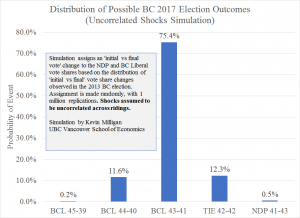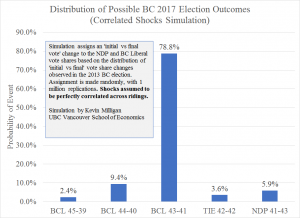BC 2017 Election Outcomes
by kevinmil
UDPATE May 12th: Elections BC has announced a revision to the preliminary count in Coquitlam-Burke Mountain which moves the margin from BC Liberal +170 to +268. This has a pretty big impact on the simulation results because it makes it much harder for the NDP to flip this riding. I’ve updated the text and charts below to reflect this change.
—
The preliminary counts from the BC election on Tuesday May 9th resulted in an apparent seat count of 43 BC Liberals, 41 NDP, and 3 BC Green MLAs. Because of the tight partisan balance, there is much interest in whether this result will hold up when all the votes are counted–around 10 percent of votes made through absentee ballots have not yet been counted. In this blog post, I first clarify how absentee and other special ballots matter. Following that, I present an analysis of the probability of a change in the outcome tallied on election night. The main finding: there is a 1 in 4 chance that the 43L-41N-3G seat count from election night will change once all the ballots are counted.
Voting in BC
In BC in 2013, about 70 percent of voters place their vote in their designated voting station. Another 20 percent voted in advance. Both of these categories are counted on election night. However, there are six more categories of voters that provide another 10 percent of votes that are not counted with the preliminary count on election day. The BC Election Act lists all eight different categories of voting, which I produce below along with the 2013 proportions of each category and the relevant section of the Election Act.
- Section 96 (69.9%): General Voting
- Section 97 (20.3%): Advance Voting
- Section 98 (0.8%): Voting at a special voting opportunity
- Section 99 (4.3%): Voting on election day, but in a different voting area
- Section 100 (1.81%): Voting on election day, but in a different electoral district
- Section 101 (0.6%): Absentee in advance
- Section 104 (2.0%) Voting in District Electoral Officer office
- Section 106 (0.4%) Voting by mail
The bottom six categories are to be counted between May 22nd and May 24th–two weeks after election day. In 2013, these six categories totaled 9.8% of total votes. Only a small fraction of this is the mail-in ballots. Most of the 9.8% is just people who voted in a polling station different than the one printed on their voting card–perhaps somewhere located more convenient to work, school, or family obligations. For 2017, Elections BC announced that the absentee total is 176,104 ballots.
Impact of Final Vote Count
The preliminary vote count on May 9th led to several close results–four districts with a lead less than 300 votes. (See all results in a google document here.) In both the 2009 and 2013 elections, two results ‘flipped’ between the initial count and the final count. If some districts flip in 2017, the partisan balance of the legislature may change. For this reason, there is strong interest in the likelihood of different seat-count scenarios. Below, I present simulations that aim to inform the public about these likelihoods.
First, let me list the five closest districts, the current lead, and the party currently in first place.
- Courtenay-Comox: 9 votes, NDP
- Maple Ridge-Mission: 120 votes, NDP
- Coquitlam-Burke Mountain: 268 votes, BC Liberal (revised from +170 in initial preliminary count)
- Richmond-Queensborough: 263 votes, BC Liberal
- Vancouver-False Creek: 560 votes, BC Liberal
When the final counts are announced, there will be extra votes for all the major parties. If the proportions of the absentee ballots differ from the proportions of the preliminary count, there will be a final count ‘bonus’ for one party or another. Some of the close races listed above will flip if these absentee ballot bonuses are large enough.
We cannot observe the absentee ballot bonuses for 2017 yet. To get a sense of whether the bonuses are likely to be large enough to flip any districts, I turn to the results of 2013. With the 2013 data, I calculate the absentee ballot bonus for each of the BC Liberal and BC NDP candidate for each district. These are measured as the gain in the percent vote share between the preliminary and final votes. So, if the BC Liberal candidate received 40.1% in the preliminary count and 40.4% in the final count, this scores as a +0.3% bonus.
For BC Liberals, here is what these absentee ballot bonuses looked like in the 85 districts in 2013.
- Mean: -0.36%
- 10th percentile: -0.66%
- 25th percentile: -0.48%
- 50th percentile: -0.36%
- 75th percentile:-0.12%
- 90th percentile:+0.04%
For the BC NDP, here is the same information for the 85 districts in 2013:
- Mean: +0.23%
- 10th percentile: -0.07%
- 25th percentile: +0.05%
- 50th percentile: +0.27%
- 75th percentile:+0.38%
- 90th percentile:+0.55%
So, there appears to be a systematic lean toward the NDP in the absentee ballot bonus. Why is that? It might result from a more energetic ‘get out the vote’ effort by the NDP. Or, it might result from a different selection of voters who make use of the absentee ballot opportunity. Either is a plausible explanation.
These kinds of absentee ballot bonuses matter. In 2013 for example, Coquitlam-Maillardville swung from +111 for the BC Liberals in the preliminary count to +41 for the NDP in the final count. This was a swing of 152 votes (or 0.70% of the final total vote count). So, the kind of swings necessary to move some 2017 districts are not impossible.
Here’s how I proceed to examine the sensitivity of the 2017 preliminary results to the absentee ballot bonuses.
- For each close district in 2017, I take the BC Liberal and NDP vote share. No seats involving the BC Greens are close enough to matter.
- I then assign an absentee ballot bonus to both of these parties in that 2017 district, drawn randomly from the set of 85 districts in 2013. Both the BC NDP and BC Liberal bonus is taken from the same 2013 district for each draw.
- This is repeated across all 5 close districts for 2017.
- I add the BC Liberal bonus to the BC Liberal initial vote share, and the same for the NDP.
- I then see if the result flips and add up the final seat count for each party.
- Repeat this 1 million times, record the results.
What can go wrong with this method?
- The 2017 distribution of absentee ballot bonuses may be different than 2013.
- The particular districts in play in 2017 may have idiosyncrasies not incorporated into the simulation. For example, Courtenay-Comox has a military base and the BC Liberal candidate served on that base. This kind of special situation is not incorporated into the simulation, since the simulation assigns a ‘generic’ absentee ballot bonus to each party.
- The absentee ballot bonus may be correlated across districts. The simulation described above assumes that each 2017 district gets an independent draw from the 2013 distribution of bonuses. Instead, it is possible that there may be a province-wide swing in favour of one party or another. That is, a correlated bonus. I account for this by presenting an alternative simulation that draws one bonus from the 2013 distribution and applies that one bonus to all the 2017 districts. This can be considered a polar case of perfect correlation to be compared to the uncorrelated case presented first.
Here are the results. First, for the uncorrelated case in which each 2017 district gets an independent draw from the 2013 absentee ballot bonuses.
Next, here is the correlated case, in which each 2017 district gets the same draw from the 2013 absentee ballot bonuses.
For the uncorrelated case, there is a 75.4% chance that the result remains unchanged at 43-41 for the BC Liberals over the NDP. About 97 percent of these are cases when no districts flipped; 3 percent are cases when the NDP gains canceled out the BC Liberal gains. So, by far the most likely outcome is no change.
However, there is still a 24.6% chance that something will change. in 11.6% of the cases, the new result is a BC Liberal majority with 44 seats. About 85 percent of these are times when Courtenay-Comox flips; 15 percent are times when Maple-Ridge Mission flips. There is also a small chance that the BC Liberals can take both Courtenay-Comox and Maple-Ridge Mission to form a slightly-more solid majority at 45-39.
Given that the NDP lead in Courtenay-Comox is only 9 votes, why is it so rare that the BC Liberals flip it? The answer is that in 2013 it was quite rare for the BC Liberals to increase their vote share with their absentee ballot bonus. Only 11 of 85 seats in 2013 saw the BC Liberal vote share grow between the preliminary and final counts. So, a 9 vote lead may be small, but the BC Liberals rarely make any gains so it may just be too much to overcome.
On the NDP side, there is a 12.3% chance that they gain a seat. This would lead to a 42-42 tie with the BC Liberals. The most likely candidate is Coquitlam-Burke Mountain, where the current deficit is now 268 votes. There is about a 9 percent chance this flips to the NDP. While it would be more of a stretch, there is still about a 6 percent chance the NDP could make up the 263 vote margin in Richmond-Queensborough. There is a very small chance that the NDP swings both seats to take a 43-41 lead. In the uncorrelated case, this probability is 0.5%, but in the correlated case this probability rises to 5.9%. This bigger chance in the correlated case happens because if the NDP happens to get a lucky draw, that lucky draw swings all their ridings. In contrast, with the uncorrelated case they need two lucky draws at the same time to swing two seats at the same time.
It is very unlikely that the NDP can attain the 44 seats necessary to reach majority status. To do so, they’d need to flip Vancouver-False Creek where they face a 560 vote (2.6%) deficit. There is no precedent from 2013 for a swing this big for the NDP. However, it is not impossible–the NDP could conceivably generate a swing larger than any they enjoyed in 2013. While not impossible, I judge this very unlikely. So, the ceiling for the BC NDP is almost surely 43 seats.
Conclusion
This blog post aims to provide a sense of the potential volatility of the final results in the 2017 BC election. Because around 10 percent of ballots are yet to be counted, up to four electoral districts may flip from one party to another when the final count is announced between May 22nd and May 24th. While the most likely scenario is no change to the status quo 43-41-3 seat count, there is about a 25 percent chance that the seat count will change.
Whatever scenario is presented to us with the Final Count at the end of May, the new legislature will be volatile. See David Moscrop in Maclean’s or Jason Markusoff (also in Maclean’s) for informative discussions of the various scenarios and how they might work.

